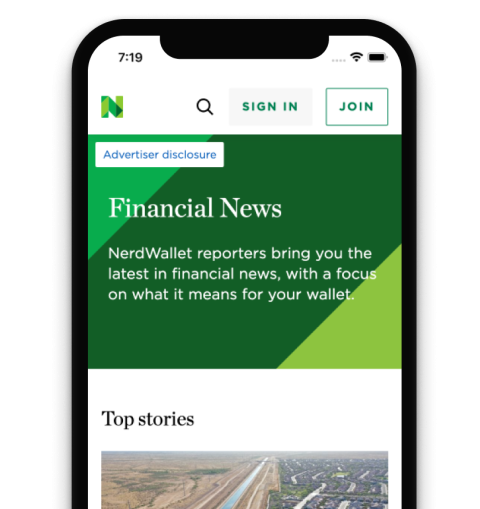Hunting Price Breaks on Groceries, Cars and TV, and an I-Bond ‘Surprise’

Many or all of the products featured here are from our partners who compensate us. This influences which products we write about and where and how the product appears on a page. However, this does not influence our evaluations. Our opinions are our own. Here is a list of our partners and here's how we make money.
Having more money in the bank — that's the goal. That means you're looking for ways to spend less, avoid markups on large purchases and maximize savings.
Some relevant recent developments might help you do just that.
A mega-merger could mean lower grocery prices
The proposed $24.6 billion Kroger purchase of Albertson's will see the merger of two of the grocery industry's top bananas. If approved by regulatory authorities, the combined chain will be better positioned to compete against Amazon and Walmart.
Industry analysts say the combination will result in significant operational savings and more negotiating power with suppliers. Kroger says it plans to invest half a billion dollars of its cost savings to reduce prices, helping consumers save on groceries.
But the deal is still waiting in the checkout lane. The Federal Trade Commission will have to approve the merger, and Kroger will likely need to sell hundreds of stores to address concerns about stifling competition.
» MORE: Read more Money News & Moves to stay in the know about your finances

Avoiding the massive markups on some new cars
By now, we've all heard about how hard it is to get a good deal on a car. Chip shortages, more pavement than product in dealer lots and soaring prices. But the latest wrinkle is something rarely seen before: dealers charging more than the manufacturer's suggested retail price for popular vehicles.
And we're not even talking about jacking the cost up with expensive dealer add-ons on a "second sticker" with such things as "paint protection" or nitrogen-filled tires.
As much as 24% is being added to the cost of some vehicles, according to an analysis by iseecars.com, an online search engine for car buyers. The new cars with the highest dealer markups were:
Jeep Wrangler (+24.4%)
Porsche Macan (+23.1%)
Genesis GV70 (+22.4%)
Lexus RX 450h (+21.9%)
Ford Bronco (+21.6%)
Luxury cars were well-represented in the top 15 vehicles with the most over MSRP cost, but in addition to the Wrangler and Bronco listed above were the MINI hardtop and Ford Maverick.
NerdWallet's automotive columnist Philip Reed suggests car buyers:
Work a deal on the add-ons. These days, there's not much you can negotiate on the original MSRP sticker from the factory, but the dealer-added options on the second sticker are fair game for haggling.
Don't get your heart set on a particular car. These days, dealers are selling inventory almost as soon as it arrives. Be prepared to walk away from a high price.
Pick a dealer with a good reputation. Read reviews from recent buyers to see if they've been stuck with last-minute profit padding.
Take your time when signing the paperwork on a car. This stage is where you can be hit with expensive extras that you may not need, such as tire protection, gap insurance and an extended warranty. In the "F&I" office (finance and insurance) where you sign the papers, these services may sound like standard procedure but they are all absolutely optional.
Streaming TV discounts
Streaming is starting to look a lot like the ancient form of telecasting called "cable." People of a certain age may remember what that was like: bundling channels, premium options, high fees. But there were free channels with advertising.
Netflix (not yet with a + sign after its name, but just wait) has rolled out details on its "Basic with ads" plan. Beginning Nov. 1, you can sign up for $6.99. That's only a $3 discount from the "Basic" plan without ads.
Suffering through the ads
So, if we've got to suffer through the ads, how come that Beginner With Training Wheels Netflix plan isn't free? Three bucks a month is all we're going to save? C'mon, Netflix. You gonna share some of that ad revenue with us lowly subscribers? Uh, no.
To really save money, you could go with the truly-free-with-ads streamers like Freevee, Pluto, Tubi, Roku or Crackle. But watch for the plus sign. That's where they get your money.
Stream free while you can
The Walmart+ membership (yes, it's got the plus, so you pay for it) offers Paramount+ for free. Verizon offers Disney+, Hulu and ESPN+ with certain phone packages. You can find bonus bundles in a lot of places: T-Mobile, Sprint, AT&T, Cricket Wireless and others.
Thing is, most of those services will relentlessly try to upsell you to their premium version. And, just like cable, the good shows will eventually be on paid channels only. On Tubi, Tubby and Chunky (I made up those last two), you'll likely just see all the shows you didn't want to watch 20 years ago.
Churn and burn
Churning involves signing up for a service to see all the good stuff and then canceling it when you're done for a while. One-third of Americans with streaming services admitted to churning in a 2021 survey by Deloitte.
This is the only real alternative we have until streaming is replaced with Elon Musk's Neuralink Network TV service. You know, brain-to-brain broadcasting. But he's not going to give that away, either.
And finally, a question I keep hearing:
Why are I bond interest rates falling?
I bonds are the inflation-era savings sensation. Generating 9.62% interest for the past six months, these bonds had savers pouring buckets of bucks into the federal savings accounts. But for buyers purchasing I bonds after Oct. 28, the rate is expected to drop to around 6.5%.
However, the annual inflation rate hasn't significantly eased, right? It's still at 8.2% for the last 12 months through September. So why the big drop in the I bond interest rate?
It's because I bonds are priced every six months, on the first of May and November, and are based on a monthly version of the Consumer Price Index. Look, it's a little like making sausage — that's probably all the details we need about how these things are put together. And even 6.5% is a dang good interest rate these days when it's being paid to you.
You can still get paid the whopping 9.62% for a full six months if you buy your I bond before Oct. 28.

